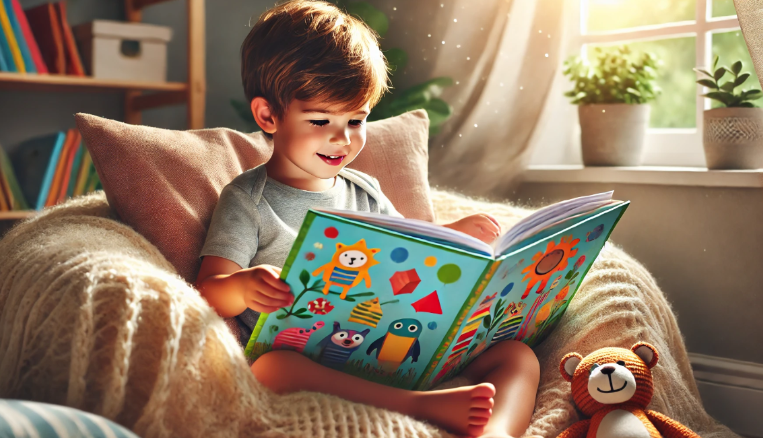In the world of children’s literature, there’s a special place for books that do more than entertain. They teach, inspire, and make little readers think. Educational children’s books take young minds on a journey filled with life lessons, curiosity, and sometimes even a little magic. Imagine telling a bedtime story that not only soothes but also explains how plants grow or why kindness matters. Now that’s a wonderful book!
Educational children’s books can also be great for read-aloud sessions, fostering classroom community and social-emotional skills.
Your Publishing Journey Awaits – Start NowEducational children’s books aren’t just for kids, either. Teachers, parents, and even librarians are on the lookout for stories that educate as much as they engage. If you’re considering writing and self-publishing a children’s book with an educational twist, you’re already on the right track. Here’s a practical guide on how to do it—without losing the fun that keeps children turning the page.
Understanding the Importance of Educational Books
Educational books play a vital role in a child’s learning and development. These wonderful books not only teach children new skills and concepts but also foster a love for reading and learning. By engaging with educational books, children can develop critical thinking, problem-solving, and communication skills, which are essential for their future success. Moreover, these books help children build empathy, self-awareness, and social skills, which are crucial for forming strong relationships.
In addition, educational books can help children develop a positive self-image and build their confidence. When kids read about characters who overcome challenges and achieve their goals, they learn valuable lessons about perseverance and determination. Furthermore, educational books spark a sense of curiosity and wonder about the world, leading to a lifelong love of learning. Whether it’s through a fun story or a captivating adventure, these books make learning an exciting journey for young readers.
Understanding the Audience: Who Are Educational Children’s Books For?
When you write for kids, age is more than just a number; it’s a roadmap. Educational children’s books come in many forms, from board books for babies learning their first words to chapter books for young readers eager to explore and for a bit of adventure. For example, toddlers and preschoolers thrive on rhyming text and vivid illustrations, while older kids (ages 6-12) prefer stories with character growth and a touch of humor. Authors like Roald Dahl, with books like ‘Charlie and the Chocolate Factory,’ offer both entertainment and valuable moral lessons.
Identifying your audience will help you choose the right tone, vocabulary, and format. You wouldn’t explain the concept of gravity to a toddler the same way you would to the father of a ten-year-old, after all.
Choosing a Theme: What to Teach and How to Make It Fun
The magic of educational children’s books lies in teaching without turning the story into a classroom lecture. To do this, pick themes that blend naturally into a storyline, like the importance of sharing, environmental care, or understanding emotions. For instance, a story about a little hedgehog who learns to share his toys and play together with friends can teach cooperation in a gentle, relatable way.
The theme you choose can be woven into the story through adventure, humor, and characters that children relate to. Take inspiration from beloved tales like The Three Little Pigs or even Roald Dahl’s classics, which entertain as they subtly also teach children. Remember, a fun story with an underlying message is one they’ll want to read again—and learn from every time.
Developing Engaging Storylines and Characters
Think of the children’s book characters you adored growing up: they probably had a bit of spunk, a dash of kindness, and maybe even some unforgettable quirks. Your main character could be a brave little fox, a curious robot, or a child exploring a magical world. What’s important is that they embark on a journey filled with small lessons, challenges, adventures, and discoveries.
Creating relatable characters with distinct personalities will keep kids invested in the story. These engaging characters and storylines can make for great read-aloud experiences, fostering a love for reading. Use a storyline that’s adventurous and entertaining yet educational, incorporating rhymes, repetitive phrases, and relatable challenges. You could even introduce simple elements of problem-solving to subtly encourage critical thinking in young readers.
Incorporating Educational Content Seamlessly
The last thing you want is for your book to feel like a quiz! Educational content should blend naturally with the story. For instance, instead of directly explaining the alphabet, try a story where the main character discovers letters in the world around them, each letter tied to a fun word or animal.
Educational books like these work best when young readers don’t realize they’re learning. Seamlessly integrated educational content can make read-aloud sessions more engaging and educational. Consider subtle themes or activities that fit the plot. If the character is on an adventure in the jungle, you could introduce animal facts along the way, allowing learning to feel like part of the fun.
Illustrations: Bringing the Story to Life
Young readers love vibrant illustrations, and in children’s books, pictures often speak louder than words. Partner with an illustrator who understands how to capture children’s imaginations, using color, expression, and details that make every page a little adventure. Original illustrations can turn your story into a visual playground, enhancing the educational aspect. Vibrant illustrations can also enhance the read-aloud experience, making it more engaging for children.
If your story focuses on teaching emotions, for example, illustrations can show the character’s feelings, helping children learn to identify and empathize with them. Use visuals strategically to reinforce the lessons without overpowering the story.
Writing and Editing Tips for Children’s Educational Books
Writing for kids requires a blend of simplicity, humor, and clarity. Avoid complex sentences and keep the language easy for little ones to follow. Test-read with children if possible to make sure the story resonates and holds their attention. Simple, catchy phrases and repeated words can make the story memorable. Additionally, writing in a way that makes the book suitable for read aloud sessions can foster classroom community and provide enjoyable reading experiences.
Editing is also essential. Make sure each word serves a purpose and that the educational message is clear but not overly obvious. A good editor can help ensure your book is both age-appropriate and enjoyable reading for children and adults alike.
Preparing Your Book for Self-Publishing
If you’re an author looking to self-publish your educational book, there are several steps you can take to ensure your book is ready for publication. First, make sure your manuscript is well-written and thoroughly edited. Consider hiring a professional editor to review your work and provide feedback on content, structure, and grammar. This step is crucial to ensure your book is polished and engaging for children.
Next, design an eye-catching cover that appeals to your target audience. Your cover should include the title of your book, your name as the author, and any relevant illustrations or graphics. A compelling cover can make a significant difference in attracting readers. Additionally, write a captivating book description that summarizes the content and highlights its unique features. This description will be key in convincing parents, teachers, and librarians to choose your book.
Your Publishing Journey Awaits – Start NowFinally, format your book according to the self-publishing platform’s guidelines. This may include converting your book into an e-book format, such as MOBI or EPUB, and creating a print-ready PDF. Proper formatting ensures that your book looks professional and is easy to read, whether it’s in digital or print form.
Choosing a Self-Publishing Platform
There are several self-publishing platforms available for authors, each with its own unique features and benefits. Some popular options include Amazon Kindle Direct Publishing (KDP), CreateSpace, Lulu, and Smashwords. When choosing a platform, consider factors such as royalty rates, distribution channels, formatting requirements, marketing tools, and customer support.
For instance, Amazon KDP offers a wide distribution network and useful marketing tools, making it a popular choice for many authors. CreateSpace, now part of KDP, provides excellent print-on-demand services. Lulu and Smashwords also offer robust self-publishing options with different strengths. Evaluate each platform to determine which one best meets your needs and goals for your educational children’s book.
Self-Publishing Process for Educational Children’s Books
Once your book is polished and ready, it’s time to self-publish. Choose a platform that supports the best educational books and children’s books with features like print-on-demand, full-color printing, and eBook options for tablets. It’s also important to select a platform that supports print-on-demand for read aloud books, which are ideal for fostering classroom community and developing social-emotional skills. Companies like Spines offer accessible self-publishing solutions that streamline the entire process, from formatting to distribution.
Think about where you want your book to end up: libraries, classrooms, or online marketplaces. Each option might have different requirements, so consider formats that appeal to teachers, parents, and, of course, children.
Marketing Your Book: Reaching Parents, Teachers, and Librarians
Publishing is only half the journey—getting your book into readers’ hands is the next challenge. For educational children’s books, target audiences such as parents, teachers, and librarians who are always on the lookout for quality educational content. Use social media platforms, educational blogs, and even book readings at classroom libraries or local schools to spread the word. Emphasize that your book is suitable for read-aloud sessions to attract parents, teachers, and librarians.
Consider offering resources for teachers, like lesson plans or activity sheets that tie into your book. Building relationships with educators and school librarians can help boost your book’s visibility and credibility, making it a staple in classroom libraries.
Self-Publish an Educational Children’s Book: Measuring Success and Impact
Once your educational book is published, it’s essential to measure its success and impact. Start by tracking sales and reader engagement using analytics tools like Amazon KDP’s reporting dashboard. This will give you insights into how well your book is performing in the market.
Engage with your readers through social media and email marketing to promote your book and gather feedback. Online reviews and surveys can provide valuable information about what readers like and dislike about your book, helping you identify areas for improvement.
Additionally, consider measuring the impact of your book on readers. Track changes in behavior, attitudes, or knowledge among children who have read your book. Surveys or focus groups can help you understand the real-world impact of your book on young readers’ lives. By continuously gathering and analyzing feedback, you can ensure your book remains a valuable educational resource for children, parents, and educators alike.
Conclusion: Inspiring the Next Generation Through Stories
Educational children’s books do more than entertain—they inspire, educate, and shape young minds. Self-publishing allows you the creative freedom to bring your vision to life while making a meaningful impact. As you embark on this journey, remember: that every story is a chance to teach, spark curiosity, and make learning magical.
If your manuscript is ready, why wait? Check out Spines, where you can upload your story and bring your educational children’s book to life. Together, let’s make childhood and learning an adventure!
Your Publishing Journey Awaits – Start Now







